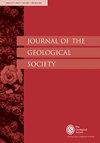古新世高温流体对苏格兰中侏罗世砂岩的混凝土胶结作用:一项聚集同位素研究
IF 3
3区 地球科学
Q2 GEOSCIENCES, MULTIDISCIPLINARY
引用次数: 0
摘要
本研究的重点是内赫布里底群岛中Jurassic Valtos砂岩组(大河口群)结核方解石胶结物的新的块状同位素数据。混杂同位素表明,结核胶结始于45±6°C,温度升至70°C以上,然后在结核边缘稍微冷却至57±7°C。在胶结的早期阶段,计算的δ18O流体值为~-12‰VSMOW,与基于古新世火成岩中心附近的热液反应对古新世赫布里底亚大气降水的估计相同。这些δ18O流体值表明,结核胶结始于古新世,可能是在潜水-岩浆喷出火成活动的最早阶段。随着结核的生长,温度变化伴随着δ18O流体成分的逐渐演变,VMOW达到+2.1±1.1‰。这些演化中的δ18O流体成分是由富含18O的岩性和沿断层向上迁移的热盆地流体之间的同位素交换反应引起的。这种流体流动是由增厚的古新世熔岩堆的渐进地壳载荷驱动的,这也导致了砂岩压实。已公布的放射性日期限制了斯凯熔岩群的侵位时间及其随后的快速侵蚀,表明结核形成和最终压实在不超过2.6 myr的时间内完成,远比之前建模的速度快。火山地形发展之前的最初结核生长表明,赫布里底亚-古新世大气降水的强负成分主要来自纬度,而不是地形。补充材料:混杂的同位素数据校正和不确定性、样本详细信息和其他数据可在https://doi.org/10.6084/m9.figshare.c.6459860本文章由计算机程序翻译,如有差异,请以英文原文为准。
Concretionary cementation of a Scottish Middle Jurassic sandstone by hot, Paleocene fluids: a clumped isotope study
This study focusses on new clumped isotope data from concretionary calcite cements in the Middle Jurassic Valtos Sandstone Formation (Great Estuarine Group) of the Inner Hebrides. Clumped isotopes show that concretion cementation began at 45±6 °C increasing to temperatures in excess of 70 °C before cooling slightly to 57 ± 7 °C at the concretion margin. In the early stages of cementation, calculated δ
18
O
FLUID
values were ∼ –12‰ VSMOW, identical to an estimate of Paleocene Hebridean meteoric water based on hydrothermal reactions close to Paleocene Igneous Centres. These δ
18
O
FLUID
values imply that concretion cementation started in the Paleocene probably during the earliest stages of phreato-magmatic effusive igneous activity. As the concretion grew, temperature changes were accompanied by progressively evolving δ
18
O
FLUID
compositions up to +2.1 ± 1.1‰ VMOW. These evolving δ
18
O
FLUID
compositions were caused by isotope exchange reactions between
18
O-rich lithologies and hot basinal fluids migrating upward along faults. This fluid flow was driven by progressive crustal loading from the thickening Paleocene lava pile which also caused sandstone compaction. Published radiometric dates that constrain the emplacement time of the Skye Lava Group, and its subsequent rapid erosion, suggest that concretion formation and final compaction was completed in no more than 2.6 myr, far more rapidly than modelled previously. Initial concretion growth that pre-dates development of volcanic topography shows that the strongly negative compositions of Hebridean Paleocene meteoric water are mainly of latitudinal rather than orographic origin.
Supplementary material:
Clumped isotope data correction and uncertainties, sample details and additional figures is available at
https://doi.org/10.6084/m9.figshare.c.6459860
求助全文
通过发布文献求助,成功后即可免费获取论文全文。
去求助
来源期刊

Journal of the Geological Society
地学-地球科学综合
CiteScore
6.00
自引率
3.70%
发文量
68
审稿时长
6-12 weeks
期刊介绍:
Journal of the Geological Society (JGS) is owned and published by the Geological Society of London.
JGS publishes topical, high-quality recent research across the full range of Earth Sciences. Papers are interdisciplinary in nature and emphasize the development of an understanding of fundamental geological processes. Broad interest articles that refer to regional studies, but which extend beyond their geographical context are also welcomed.
Each year JGS presents the ‘JGS Early Career Award'' for papers published in the journal, which rewards the writing of well-written, exciting papers from early career geologists.
The journal publishes research and invited review articles, discussion papers and thematic sets.
 求助内容:
求助内容: 应助结果提醒方式:
应助结果提醒方式:


